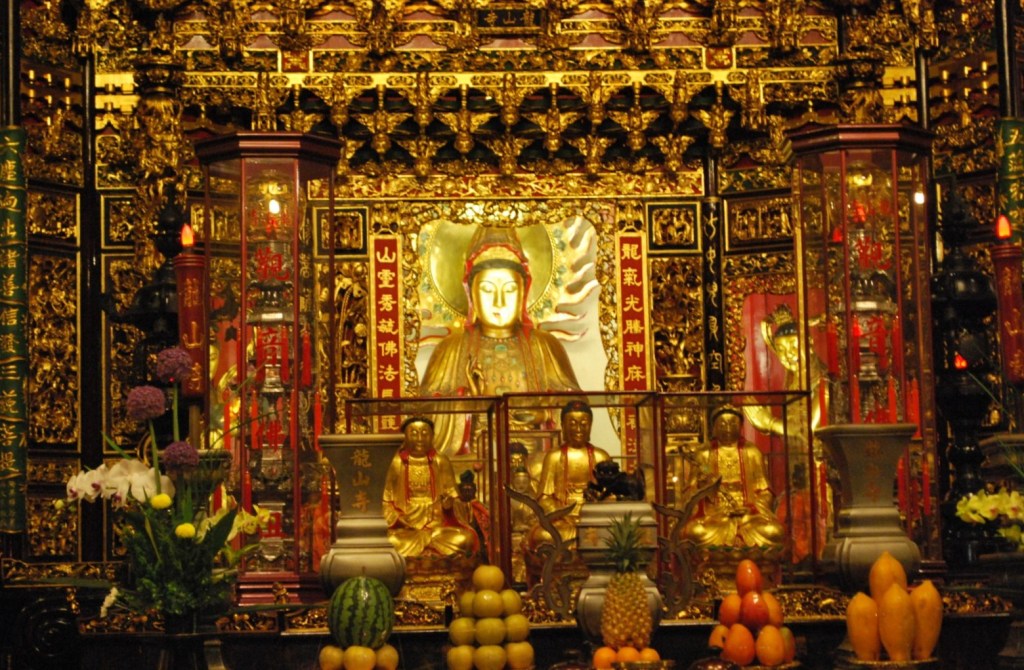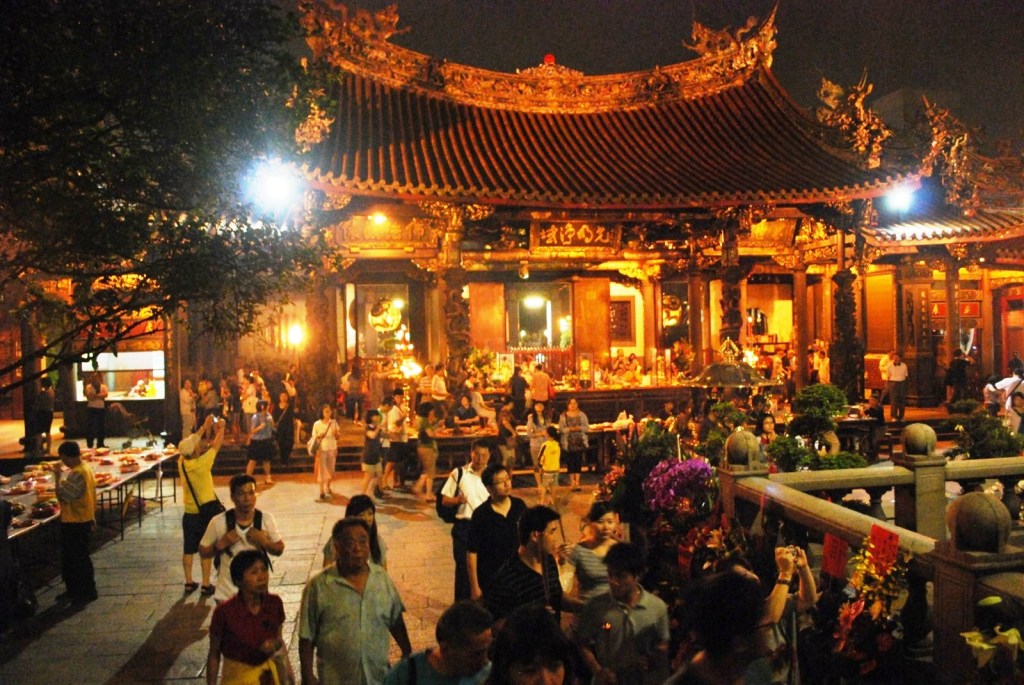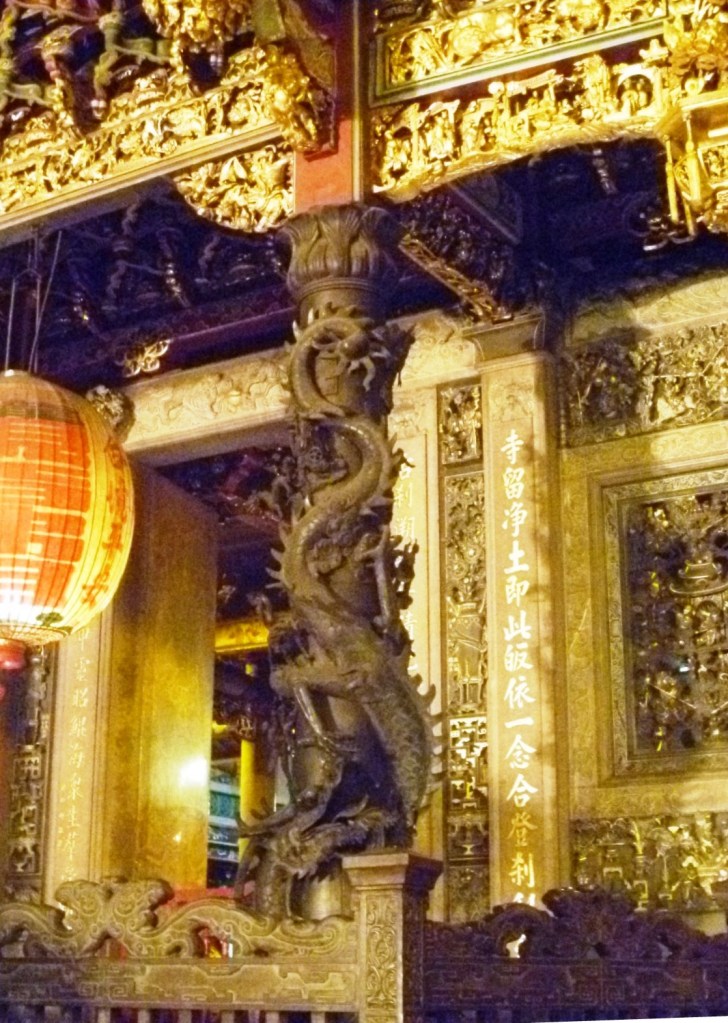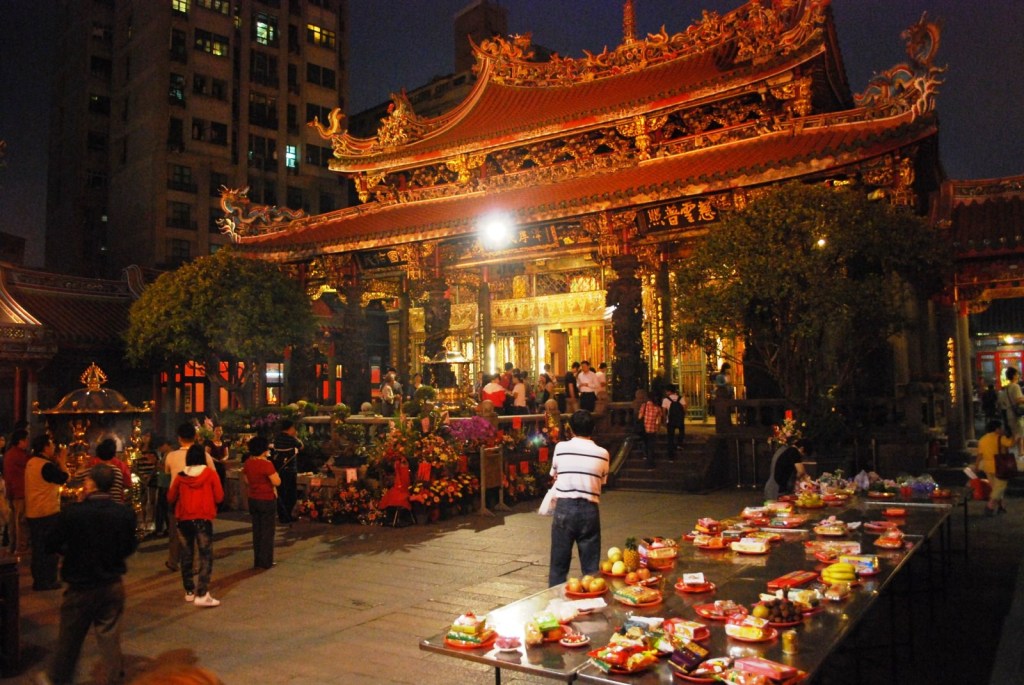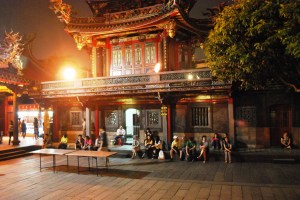From Taipei 101, Jandy, Isha and I again walked to the Taipei City Hall MRT Station where we boarded the MRT to Longshan MRT Station. It was just about dusk when we arrived at the station. Before exiting, we all bought cups of coffee for take out and, upon exiting, leisurely sipped it while watching a Chinese dance being performed, beside the fountain, at Manka Park.
After finishing our coffee, we all walked over to the Mengjia Longshan (also spelled as Lungshan) Temple in front of the park, one of Taiwan’s most important places of worship. Surrounding the temple are antique shops, Buddhists article shops, fortune tellers, traditional Chinese medicine shops and paper stores selling paper products that are burned for the deceased.
Built in 1738 (during the Qing Dynasty), on a much smaller scale, as the spiritual center of Han settlers from the Jinjiang, Nan’an and Hui’an districts of Quanzhou County, Fujian, China, the temple has been destroyed, either in full or in part, by numerous earthquakes and fires. Nevertheless, Taipei residents have consistently rebuilt and renovated it. From 1919-1924, it was renovated, in large scale, under the direction of famous architect Wang Yi-shun, a master of temple building in Fukien.
On June 8, 1945, during World War II, it was hit by American bombers, who claimed that the Japanese were hiding armaments inside. The whole main hall and a part of the right annex were damaged and many precious artifacts and artworks were lost in the ensuing fire. The fire somehow missed the statue of Avalokiteshvara (in Sanskrit) or Guanyin (short for Guanshiyin which means “observing the sounds of the world”), the Buddhist Goddess of Mercy (only her toes were singed), even though the iron railing around her melted. After the end of the war, a few months later, the temple was again rebuilt.
On August 19, 1985, Longshan Temple was designated as Taipei City’s fourth official historical site (after the Chang Kai-shek Memorial Hall, National Palace Museum and Taipei 101). The temple, one of the oldest and largest in Taiwan, has also been declared a Secondary National Heritage Site.
We entered the temple’s gateway and, at the courtyard, noticed a small, man-made waterfall (the Waterfall of Cleaning Your Heart) on one side and a lucky dragon fountain on the other. The temple was already packed with locals either praying, reciting religious chants, lighting candles or burning incense sticks. They worship a mixture of Buddhist, Taoist and folk deities such as Guanyin (also called Kuan-in), the main deity, Buddha, Matsu and other divine spirits. Thus, it is often called “meeting place of the gods” for the wealth of deities worshipped here. We didn’t see any Western tourists.
The resplendent Longshan Temple, with southern Chinese influences commonly seen in older buildings, is an emblematic example of Taiwanese Classical architecture. Facing the south and mixing traditional Chinese siheyuan (“four-building courtyard”) with palace architecture in its design, it has a fore hall, main hall, a rear hall (added around the end of the 18th century) and a left and right wing.
The Yuan-Tung Grand Hall, the main hall, is the center of the whole complex. It houses the statue of Guanyin. The rear hall is divided into 3 parts. The center is for the veneration of Matsu, the goddess of marine voyage, the left is dedicated to the gods of literature (or patrons of examination for civil service in the olden days) and the right is for Lord Kuan, the god of war.
The octagonal ceiling in its fore hall, the clock tower roof, and the circular ceiling (with its 7-layered spiral plafond) in the main hall are exceptionally elegant. Its doors, beams and poles are also beautifully decorated.
A treasure trove of folk art, its fore hall is graced by a pair of unique bronze dragon pillars while the main hall has four pairs. The walls and ceilings are covered by exquisitely delicate sculptures as well as many Chinese poems, verses and lyrics on signs, adding a touch of literature. The temple walls are graced with paintings of vivid creatures while stone statues of mystical creatures guard the temple grounds. The wall and the roof are joined without the use any nails or braces made of metal.
The temple roof, representing the pinnacle of mosaic art in Taiwan, is covered with overlapping tiles and is decorated with figures of dragons, phoenixes and other auspicious creatures, all decorated with porcelain, clay, and shards of colored glass.
Two 2-storey buildings, one housing the bell on the east and a drum on the west side of the courtyard, between the fore hall and the main hall, have conic, hexagonal roofs with double eaves that forms a converse “S” curve, the first such roof design in Taiwan.
Mengjia Longshan Temple: 211 Guangzhou St., Old Town Center, Wanhua District, Taipei City, Taiwan. Tel: (+886-2) 2302-5162. Website: http://www.lungshan.org.tw. Open daily, 6 AM-10:20 PM. Admission is free.




